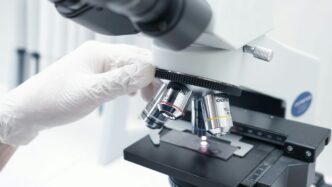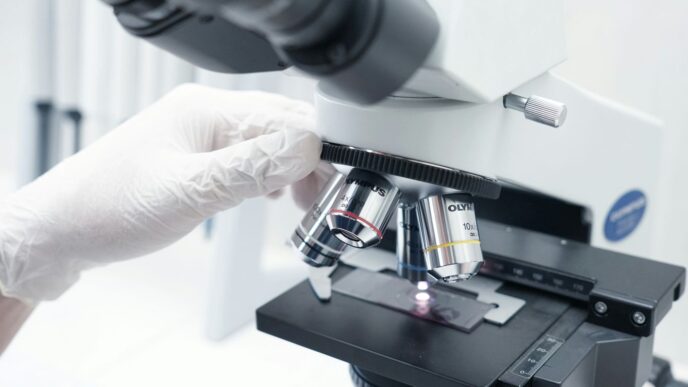Cancer remains a major health concern, and finding it early is key to better outcomes. Thankfully, artificial intelligence, or AI, is changing how we look for and treat cancer. It’s like having a super-smart assistant that can sift through tons of information way faster than we ever could. This technology is not just about spotting cancer sooner; it’s also helping doctors figure out the best way to treat each person. We’re seeing AI make a real difference in everything from reading scans to understanding our genes, and it’s paving the way for more personalized care.
Key Takeaways
- AI is significantly improving how we see potential cancer in medical images, like mammograms, making it easier to find even small signs.
- Using AI, we can better predict who might get cancer by looking at health records and finding patterns humans might miss.
- Digital pathology is getting a boost from AI, helping speed up the work of analyzing tissue samples and improving accuracy.
- AI is a big help in precision medicine, looking at a person’s unique genetic makeup to suggest the most fitting treatments.
- While AI offers a lot of promise in cancer care, we still need to sort out issues like data fairness, rules, and the cost of putting these tools into practice.
Advancements in Medical Imaging Diagnostics
Medical imaging has always been a cornerstone of spotting cancer, but AI is really changing the game. Think of it like giving radiologists super-powered glasses. These systems can sift through scans like mammograms, CTs, and MRIs with incredible speed and detail, spotting things that might be easy to miss with the human eye. This isn’t about replacing doctors, but about giving them better tools to catch cancer earlier and more accurately.
Enhanced Sensitivity in Breast Cancer Screening
When it comes to breast cancer, early detection is key. AI algorithms, especially those using deep learning, are getting really good at analyzing mammograms. They can pick out subtle signs of malignancy that might be overlooked, particularly in dense breast tissue where abnormalities can be harder to see. Some studies show AI models performing as well as, or even better than, experienced radiologists in identifying suspicious areas, leading to fewer false positives and negatives. This means fewer unnecessary biopsies and a quicker path to diagnosis for those who need it.
Improved Detection in Dense Breast Tissue
Dense breast tissue is a well-known challenge in mammography. The glandular and fibrous tissue can obscure tumors, making them harder to spot. AI is proving to be a real help here. By learning from vast amounts of data, these systems can better differentiate between normal dense tissue and potential cancerous growths. They can highlight areas that warrant a closer look, giving radiologists a significant advantage when examining these complex images.
AI-Assisted Radiographic Interpretation
Radiologists interpret a huge number of images daily. AI can act as a second pair of eyes, flagging potential issues and prioritizing cases. This doesn’t mean the AI makes the final call; rather, it helps streamline the workflow. It can automate some of the more repetitive tasks, like measuring lesions or comparing current scans to previous ones, freeing up the radiologist to focus on the most challenging cases and complex interpretations. This collaborative approach promises to make the entire diagnostic process more efficient and reliable.
Here’s a look at how AI is being applied:
- Image Classification: Sorting scans into categories, like ‘normal’ or ‘suspicious’.
- Segmentation: Outlining specific areas of interest, such as tumors or organs.
- Detection & Localization: Pinpointing the exact location of abnormalities within an image.
The ability of AI to process and analyze complex visual data at scale is a significant leap forward. It’s not just about finding cancer; it’s about finding it sooner and with greater certainty, which can make all the difference for patients.
The Role of AI in Predictive Analytics
Think about it: wouldn’t it be great if we could get a heads-up about potential health issues before they become serious problems? That’s where AI is really starting to shine in predicting what might happen with diseases like cancer. It’s not about predicting the future with a crystal ball, but more about spotting patterns in huge amounts of data that humans might miss.
Forecasting Disease Incidences
One of the most exciting areas is using AI to guess how often certain cancers might pop up in different groups of people. For example, researchers have used AI to look at millions of patient records, not just for cancer itself, but for all sorts of other health codes and when they happened. By doing this, the AI could figure out who was more likely to get a specific cancer, like pancreatic cancer, even if the initial health codes weren’t directly related to the pancreas. This approach turned out to be pretty good, sometimes even better than what we can do now with genetic tests, which are usually only available for a small number of people.
Identifying High-Risk Patient Populations
AI can also help us pinpoint individuals or groups who might be more prone to developing cancer. It does this by sifting through all sorts of information – think medical history, lifestyle factors, even environmental data. By finding connections between these different pieces of information, AI can flag people who might benefit from earlier or more frequent screenings. This is a big deal because it means we can focus our resources where they’re needed most and potentially catch cancers at their earliest, most treatable stages.
Uncovering Hidden Health Trends
Beyond just predicting individual cases, AI is amazing at finding broader trends in health data. It can look across massive datasets and discover links between things like diet, where someone lives, or even their job, and their risk of developing cancer. These are the kinds of subtle connections that are really hard for us to see on our own.
AI’s ability to process and find meaning in complex, multi-faceted data is what makes it so powerful for prediction. It’s like having a super-powered detective that can examine millions of clues simultaneously, revealing insights that would otherwise remain hidden. This capability is transforming how we think about disease prevention and early detection.
Here’s a look at how AI can help identify risk factors:
- Data Integration: AI can combine data from electronic health records, genetic tests, lifestyle surveys, and environmental sensors.
- Pattern Recognition: Sophisticated algorithms identify subtle correlations and patterns that indicate increased risk.
- Risk Stratification: Patients are categorized into different risk levels, allowing for tailored screening and prevention strategies.
- Predictive Modeling: AI builds models that forecast the likelihood of disease development over specific timeframes.
AI’s Impact on Digital Pathology
Digital pathology is really changing how we look at cancer samples. Instead of just looking down a microscope, we now scan slides into super high-resolution digital images. This opens the door for AI to do some pretty amazing things.
Automating Pathologist Workflows
Think about all the time pathologists spend looking at slides. AI can help speed this up a lot. It can sort through images, flag areas that look suspicious, and even do some initial classifications. This means pathologists can spend less time on routine tasks and more time on the really complex cases that need their expert judgment. It’s like giving them a super-powered assistant.
Enhancing Diagnostic Accuracy with Digital Slides
When you digitize slides, you get a consistent, high-quality image every time. AI can analyze these digital images with incredible detail, sometimes spotting things that might be missed by the human eye, especially in early-stage cancers. It’s not about replacing pathologists, but about giving them better tools to make more accurate diagnoses. For example, AI has already been approved to help detect prostate cancer from biopsy slides, classifying them as suspicious or not suspicious.
Biomarker Detection Innovations
Finding specific biomarkers in tissue samples is super important for understanding cancer and deciding on treatment. Traditional methods can be slow and sometimes not as precise as we’d like. AI models are getting really good at identifying these biomarkers directly from the digital pathology images. Some studies show AI can even predict things like MSI and BRAF mutations, which are key for certain cancer treatments. While not all predictions are perfect yet, this is a huge step forward in getting patients the right treatment faster.
The integration of AI into digital pathology isn’t just about making things faster; it’s about improving the quality and consistency of diagnostic information. This can lead to earlier detection and more tailored treatment plans for patients.
Here’s a look at how AI is making a difference:
- Automated Screening: AI can quickly scan through large numbers of slides, identifying potential abnormalities for pathologist review.
- Quantitative Analysis: AI provides precise measurements and counts of cells or features, removing subjective variability.
- Predictive Insights: By analyzing patterns, AI can help predict how a tumor might behave or respond to certain therapies.
- Quality Control: AI can flag slides with issues like poor staining or artifacts, improving overall data reliability.
Precision Medicine and Personalized Treatment

This section is all about tailoring medical care to the individual. Instead of a one-size-fits-all approach, precision medicine uses a person’s unique genetic makeup, lifestyle, and environment to guide treatment and prevention strategies. AI is a big player here, helping us make sense of all that complex data.
Genomic Profiling for Targeted Therapies
Cancer isn’t just one disease; it’s many, and each tumor can be a bit different. AI tools are getting really good at looking at the genetic code of a tumor. By analyzing this information, we can figure out which specific drugs are most likely to work for that particular cancer. This means fewer side effects and a better chance of success.
- AI can sift through vast amounts of genomic data much faster than humans.
- It helps identify specific mutations or markers that a drug can target.
- This leads to more effective treatments, especially for complex cancers like lung or breast cancer.
Real-Time Treatment Recommendations
Once we have the genetic profile, AI can help doctors make decisions on the fly. Imagine a system that can look at a patient’s genetic data and instantly suggest the best treatment options, considering the latest research and clinical trial results. That’s what AI is starting to enable.
The ability to process and interpret complex biological data in real-time is a game-changer for cancer care. It allows for dynamic adjustments to treatment plans as new information becomes available or as the patient’s condition changes.
Predictive Calculators for Optimal Care
AI can also be used to build models that predict how a patient might respond to different treatments. These aren’t just guesses; they’re based on analyzing data from thousands of similar cases. This helps doctors and patients choose the path that offers the best chance of a good outcome while minimizing risks.
Here’s a simplified look at how it works:
- Data Input: Patient’s genetic data, tumor characteristics, medical history, and lifestyle factors are fed into the AI model.
- Analysis: The AI compares this information against a large database of similar cases and treatment outcomes.
- Prediction: The model generates probabilities for the effectiveness and potential side effects of various treatment options.
- Recommendation: Doctors use these predictions to discuss the most suitable treatment plan with the patient.
Streamlining Cancer Care with AI

Artificial intelligence is really changing how we handle cancer, making things faster and more effective. It’s not just about finding cancer early anymore; AI is helping us speed up the whole process, from creating new medicines to making sure patients get the best possible care.
Accelerating Drug Discovery and Development
Developing new cancer drugs used to take ages. Now, AI can sift through massive amounts of data to spot potential drug candidates much quicker. It can predict how a drug might work or even find new uses for existing ones. This means promising treatments could reach patients sooner.
- Identifying novel compounds for drug development.
- Predicting drug interactions and effectiveness.
- Repurposing existing medications for cancer treatment.
AI’s ability to process complex biological data at speeds humans can’t match is a game-changer for getting new therapies into the pipeline.
Improving Surgical Precision
When it comes to surgery, AI is helping surgeons be more precise. Robotic systems guided by AI can perform delicate maneuvers with incredible accuracy, leading to less invasive procedures. This often means quicker recovery times and fewer complications for patients.
| Procedure Type | AI Assistance | Benefit |
|---|---|---|
| Tumor Resection | Robotic Guidance | Reduced invasiveness, higher precision |
| Biopsy | Enhanced Imaging | More accurate sample collection |
| Reconstruction | Pre-operative Planning | Improved outcomes, reduced errors |
Facilitating Patient Monitoring and Management
Keeping track of patients during and after treatment is also getting a boost from AI. Wearable devices and AI algorithms can monitor a patient’s condition in real-time, alerting doctors to any issues before they become serious. This allows for more proactive care and better management of side effects.
- Remote patient monitoring for early detection of complications.
- Personalized follow-up schedules based on individual recovery.
- Predicting potential adverse events from treatments.
Addressing Challenges in AI Implementation
While AI holds immense promise for cancer diagnostics, getting these powerful tools into everyday clinical practice isn’t as simple as flipping a switch. There are some pretty significant hurdles we need to clear before AI can truly revolutionize how we detect and treat cancer. It’s not just about the tech itself, but how it fits into the complex world of healthcare.
Mitigating Dataset Biases
One of the biggest headaches with AI is the data it learns from. If the data used to train an AI model doesn’t accurately represent the diverse patient population, the AI can end up being biased. This means it might work great for one group of people but poorly for others, potentially worsening existing health disparities. We’ve seen instances where AI, despite initial accuracy, introduced errors when interacting with human experts, especially under pressure. This highlights the need for careful data curation and validation.
- Data Auditing: Regularly checking training datasets for underrepresentation or overrepresentation of certain demographics.
- Synthetic Data Generation: Creating artificial data that mimics real-world diversity to supplement existing datasets.
- Bias Detection Tools: Developing and using computational methods to identify and quantify bias within datasets before model training.
The ‘black box’ problem, where AI decision-making processes are opaque, is a major concern. Clinicians need to understand why an AI makes a certain recommendation to trust it. Explainable AI (XAI) is a growing field focused on making these systems more transparent, which is key for building confidence and ensuring responsible use.
Ensuring Regulatory Compliance
Healthcare is a heavily regulated field, and AI is no exception. New AI tools need to meet strict standards for safety, effectiveness, and privacy. The regulatory landscape for AI in medicine is still catching up, which can slow down the adoption of promising technologies. Frameworks like STARD-AI and TRIPOD-AI are emerging to help standardize how AI studies are reported, making them more reproducible and comparable.
| Framework | Focus Area |
|---|---|
| CLAIM | Checklist for AI in Medical Imaging |
| FUTURE-AI | Best practices for trustworthy AI in healthcare |
Overcoming Cost Barriers
Implementing AI systems can be expensive. This includes the cost of the technology itself, the infrastructure needed to support it, and the training required for healthcare professionals. For smaller clinics or hospitals with limited budgets, these costs can be a major obstacle. Finding ways to make AI solutions more affordable and demonstrating a clear return on investment is vital for widespread adoption. It’s a balancing act between innovation and accessibility, and we’re still figuring out the best way to manage it.
The Road Ahead
So, where does all this leave us? It’s pretty clear that artificial intelligence is shaking things up in the fight against cancer. We’re seeing AI get really good at spotting cancer earlier than before, sometimes finding things that might have been missed. It’s helping doctors figure out the best way to treat each person, kind of like a custom plan. But, it’s not all smooth sailing. We still need to make sure the AI tools are fair for everyone, that they’ve been tested enough in real-world situations, and that they fit into how doctors already work. There are also rules to figure out and costs to consider. Still, the potential is huge. AI is giving us new hope for catching cancer sooner and treating it better, making things more personal for patients. As this technology keeps getting better, we can expect even bigger steps forward in how we handle cancer.












